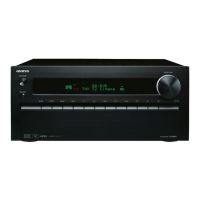
Do you have a question about the Onkyo TX-NR1009 and is the answer not in the manual?
| front left/right power output | 180 W/Ch (6 Ω, 1 kHz, 1%, 1 channel driven, IEC) |
|---|---|
| center power output | 180 W (6 Ω, 1 kHz, 1%, 1 channel driven, IEC) |
| surround left/right power output | 180 W/Ch (6 Ω, 1 kHz, 1%, 1 channel driven, IEC) |
| surround back left/right power output | 180 W/Ch (6 Ω, 1 kHz, 1%, 1 channel driven, IEC) |
| dynamic power | 300 W (3 Ω, Front) |
| total harmonic distortion + noise | 0.08% (20 Hz–20 kHz, Half power) |
| damping factor | 60 (Front, 1 kHz, 8 Ω) |
| input sensitivity and impedance | 200 mV/47 kΩ (Line) |
| phono overload | 70 mV (MM, 1 kHz, 0.5%) |
| video input sensitivity/output level and impedance | 1.0 Vp–p/75 Ω (Component and S-Video Y) |
|---|---|
| component video frequency response | 5 Hz–100 MHz/0 dB, -3 dB |
| composite input sensitivity/output level and impedance | 1.0 Vp–p/75 Ω (Composite) |
| fm tuning frequency range | 87.5 MHz–108 MHz |
|---|---|
| am tuning frequency range | 522 kHz–1, 611 kHz |
| fm/am preset memory | 40 stations |
| power supply | AC 220–240 V~, 50/60 Hz |
|---|---|
| power consumption | 830 W |
| dimensions | 435 x 198.5 x 435.5 mm |
| weight | 18.5 kg |
Essential instructions for safe operation, including electrical and environmental hazards.
Guidelines for servicing, damage assessment, and handling spills or drops.
Identification and function of front panel elements.
Ports for composite, S-Video, component, analog audio, and monitor connections.
Ports for digital audio, HDMI, and radio antennas.
Using the remote to control receiver functions.
Illustrated guide for connecting speaker wires to terminals.
Table indicating speaker channel usage based on setup.
Important warnings and guidelines before connecting speakers.
Overview of connecting components via HDMI and other cables.
Default assignments for HDMI input jacks.
Procedures for powering on the AV receiver.
Procedures for powering off the AV receiver.
Using the remote to play and control connected sources.
Controlling content from USB drives and network devices.
Guide for playing music/video from iPod/iPhone using USB.
Requirements for listening to internet radio.
Specific guide for using the vTuner internet radio service.
Steps to play music files from a computer or media server.
How to use the built-in AM/FM tuner.
Methods for tuning into radio stations (Auto/Manual).
Storing favorite AM/FM stations as presets.
Guide to automatic speaker setup using the microphone.
Steps involved in the speaker measurement process.
Saving settings and options after speaker setup.
Manually changing speaker settings after automatic setup.
Manually adjusting speaker settings for optimal performance.
Identification and function of remote buttons for selecting listening modes.
How to navigate the Home menu for Input, Audio, Video, Info, and Listening Mode settings.
Overview of the nine main categories in the setup menu.
General procedures for selecting and changing settings using menus.
Assigning input and output signals for various ports.
Adjusting speaker settings automatically or manually.
Fine-tuning audio settings like bass, treble, and Audyssey.
Configuring source-specific settings like Audyssey and IntelliVolume.
Setting monitor output for video signals.
Configuring output resolution for HDMI signals.
Fine-tuning speaker impedance, type, and zone settings.
Using a 7-band equalizer to adjust speaker tone.
Settings for Dolby Volume and Volume Leveler functions.
Enabling or disabling Audyssey processing for movies and music.
Settings for Dynamic EQ and its reference level offsets.
Settings for Audyssey Dynamic Volume feature.
Selecting predefined picture modes like Cinema or Game.
Setting audio output priority for digital/analog inputs.
Enabling HDMI-CEC for component control.
Setting up ARC for TV audio transmission to the receiver.
Details on updating firmware via network or USB.
Adjusting Bass and Treble for front speakers.
Detailed settings for Audyssey Dynamic EQ and Volume.
Connecting zone speakers directly or via an additional amplifier.
Setup for powering Zone 2/3 speakers from the AV receiver.
Overview and notes on using the optional Onkyo Dock.
Using remote control codes to manage iPod/iPhone via dock.
Procedure to search for and retrieve remote control codes.
Programming sequences of actions into ACTIVITIES buttons.
Information on updating firmware using a network connection.
Detailed steps for performing the network firmware update.
Step-by-step instructions for updating firmware using a USB device.
Features enabled by connecting RIHID-compatible TVs and players.
Diagram and requirements for connecting to a home network.
Essential requirements for Ethernet network and cable.
Technologies and system requirements for server playback.
Specifications and compatibility for USB storage devices.
Detailed specifications for the amplifier section.
